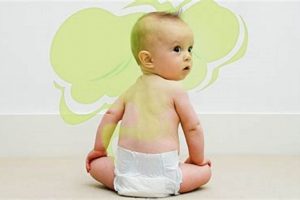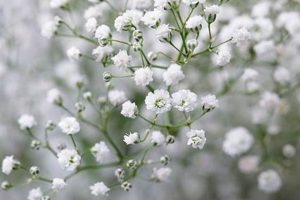The perception of scent associated with Gypsophila paniculata, commonly known as Baby’s Breath, is subjective and varies significantly among individuals. While often utilized in floral arrangements for its delicate aesthetic, some perceive an unpleasant odor emanating from the plant, which may be described as musty, earthy, or even similar to decaying organic matter. This contrasts with the intended fragrance of many commercially used flowers, creating a potential olfactory dissonance for certain individuals.
The presence or absence of a favorable aroma can impact the perceived value and overall experience associated with floral arrangements and bouquets. Considering potential allergenic reactions and individual sensitivities regarding specific plant-derived scents is crucial in the selection and handling of cut flowers. Historically, floral scents have played a significant role in various cultural practices, ranging from religious ceremonies to expressions of affection, indicating the considerable importance of olfactory perception in human interaction.
This article will delve further into the potential chemical compounds responsible for the range of olfactory experiences associated with Baby’s Breath. It will also explore the factors that can influence these scent profiles, including cultivation practices, storage methods, and the plant’s overall state of maturity. Finally, the article will address strategies to mitigate undesirable odors and enhance the overall sensory experience when incorporating Baby’s Breath into floral displays.
Mitigating Unpleasant Olfactory Experiences Associated with Baby’s Breath
The following guidelines are designed to minimize the potential for negative scent perception when utilizing Baby’s Breath in floral arrangements or other applications. Proper handling and informed selection are key to a positive sensory experience.
Tip 1: Source Selection. Procure Baby’s Breath from reputable suppliers with established quality control measures. Inquire about cultivation practices and post-harvest handling procedures to ensure optimal freshness and minimize potential odor development during storage and transport.
Tip 2: Thorough Inspection. Upon receiving Baby’s Breath, meticulously examine the stems and blooms for signs of decay, discoloration, or fungal growth. Discard any affected stems immediately to prevent the spread of undesirable odors.
Tip 3: Proper Hydration. Maintain adequate hydration levels to prolong the freshness of Baby’s Breath. Utilize a floral preservative solution in the water to inhibit bacterial growth and reduce the likelihood of unpleasant odors emanating from stagnant water.
Tip 4: Adequate Ventilation. Store Baby’s Breath in a well-ventilated environment to prevent the build-up of moisture and the proliferation of odor-causing microorganisms. Avoid confining the flowers in enclosed spaces for extended periods.
Tip 5: Selective Pairing. Be mindful of complementary scents when incorporating Baby’s Breath into mixed floral arrangements. Stronger, more appealing fragrances from other flowers can effectively mask any subtle, less desirable odors associated with Baby’s Breath.
Tip 6: Drying Procedures. If drying Baby’s Breath for preservation, ensure proper air circulation and avoid humid environments. Rapid and complete drying can help minimize the development of musty or earthy odors during the drying process.
Careful implementation of these recommendations can significantly reduce the risk of encountering undesirable odors associated with Baby’s Breath, thereby enhancing the overall aesthetic and sensory appeal of floral creations.
The subsequent section will delve into alternative floral options that offer similar aesthetic qualities to Baby’s Breath, providing alternatives for individuals with heightened olfactory sensitivities.
1. Subjective Experience
The assertion that Gypsophila paniculata, commonly known as Baby’s Breath, “smells bad” is fundamentally rooted in subjective olfactory perception. Individual variations in sensory processing and interpretation significantly influence the experience of scent. While some may find the odor neutral or even pleasant, others perceive it as disagreeable. Therefore, understanding the nuances of subjective experience is paramount when discussing olfactory qualities.
- Individual Olfactory Sensitivity
Genetic predispositions, past experiences, and overall health influence an individual’s sensitivity to specific odor molecules. Individuals with heightened sensitivity may detect volatile compounds at lower concentrations, leading to a more pronounced perception of any perceived negative scent associated with Baby’s Breath.
- Cultural and Personal Associations
Cultural norms and personal experiences shape olfactory preferences and associations. A particular scent may evoke positive memories for one individual but negative associations for another. Prior exposure to similar odors, particularly in unpleasant contexts, can contribute to a negative perception of Baby’s Breath’s scent.
- Physiological Factors
Physiological factors such as age, hormonal changes, and even temporary conditions like nasal congestion can alter olfactory perception. Older individuals may experience a decline in olfactory sensitivity, while hormonal fluctuations during pregnancy can heighten sensitivity to certain odors. These physiological variations contribute to the diverse range of scent experiences.
- Psychological Influences
Expectations and preconceptions significantly impact sensory perception. If an individual anticipates Baby’s Breath to have an unpleasant odor, they are more likely to perceive it negatively. This expectation can be influenced by prior warnings, anecdotal reports, or general biases about floral scents.
In summary, whether or not Baby’s Breath “smells bad” is not an objective truth but rather a complex interplay of individual olfactory sensitivity, cultural associations, physiological factors, and psychological influences. Recognizing this inherent subjectivity is crucial for understanding the varied responses to the plant’s scent and for making informed decisions regarding its use in floral arrangements.
2. Decay Indicators and Gypsophila paniculata Odor
The deterioration of Gypsophila paniculata, commonly known as Baby’s Breath, directly correlates with the emanation of undesirable odors. “Decay indicators” serve as critical signifiers that degradation processes are underway, transforming the plant’s inherent, often subtle, scent profile into an unpleasant one. The breakdown of cellular structures releases volatile organic compounds (VOCs), resulting in the perceived “babys breath smells bad.” These indicators are not merely aesthetic; they represent a biological shift affecting scent.
Observable decay indicators include discoloration (browning or yellowing of stems and florets), wilting, and the presence of visible mold or fungal growth. These visual cues are frequently accompanied by a characteristic increase in odor intensity and a shift towards less desirable scent profiles, such as musty, ammonia-like, or putrescent smells. For example, a Baby’s Breath bouquet left in stagnant water for an extended period exhibits these indicators: the stems become slimy, the florets droop, and the bouquet emits a distinctly foul odor attributable to bacterial decomposition. The timely identification of such decay indicators facilitates prompt removal, preventing further odor propagation within the surrounding environment. Similarly, Baby’s Breath shipped in poorly ventilated containers can arrive already exhibiting early decay indicators, leading to customer dissatisfaction. Therefore, vigilance in observing these signs is of paramount importance.
In conclusion, the presence of decay indicators in Baby’s Breath is a reliable predictor of an undesirable odor profile. The timely recognition and response to these indicators are crucial for mitigating unpleasant scents and ensuring a positive sensory experience. Further research into the specific VOCs released during decomposition may offer avenues for developing preservation techniques that minimize odor production, addressing the broader challenge of maintaining Baby’s Breath’s appeal throughout its lifecycle.
3. Bacterial presence
The presence of bacteria significantly influences the olfactory characteristics of Gypsophila paniculata, or Baby’s Breath. Bacterial proliferation on the plant’s surfaces and within its vascular system leads to the production of volatile organic compounds (VOCs) that contribute to the perception that “babys breath smells bad.” The type and concentration of these VOCs directly impact the perceived odor.
- Decomposition Processes
Bacteria initiate the decomposition of plant tissues, metabolizing sugars, amino acids, and other organic compounds. This metabolic activity generates a variety of VOCs, including sulfur-containing compounds (e.g., methanethiol, dimethyl sulfide) and short-chain fatty acids (e.g., butyric acid, isovaleric acid). These compounds often possess unpleasant odors described as sulfurous, putrid, or cheesy, contributing significantly to the overall negative olfactory experience. For example, stagnant water in a vase containing Baby’s Breath provides an ideal environment for bacterial growth, accelerating decomposition and the release of these malodorous compounds.
- Biofilm Formation
Bacteria can form biofilms on the stems and within the water of floral arrangements. These biofilms are structured communities of microorganisms encased in a self-produced matrix of extracellular polymeric substances. Biofilms enhance bacterial survival and proliferation, exacerbating the production of odor-causing VOCs. The presence of a slimy or cloudy film on the stems of Baby’s Breath indicates biofilm formation, correlating with increased odor intensity. Floral preservatives often target biofilm formation to extend the lifespan of cut flowers and mitigate unpleasant odors.
- Water Quality Impact
The quality of water used in floral arrangements directly influences bacterial growth and odor production. Tap water may contain minerals and organic matter that support bacterial proliferation. Conversely, distilled or filtered water can help reduce bacterial growth. Regular water changes and the addition of floral preservatives containing antibacterial agents are essential to minimize the presence of bacteria and control odor development. Experiments comparing the odor profiles of Baby’s Breath in tap water versus distilled water demonstrate a marked difference, with tap water arrangements exhibiting more pronounced off-odors.
- Species-Specific Interactions
Different bacterial species exhibit varying metabolic capabilities and produce distinct VOC profiles. The specific community of bacteria colonizing Baby’s Breath can, therefore, influence the specific types of unpleasant odors detected. Certain species may be particularly adept at producing sulfurous compounds, while others may generate higher concentrations of fatty acids. Understanding the specific microbial ecology of Baby’s Breath arrangements could allow for targeted interventions to inhibit the growth of odor-producing bacteria.
The presence of bacteria and their subsequent metabolic activities directly contribute to the perception that “babys breath smells bad.” Controlling bacterial growth through proper sanitation, water management, and the use of floral preservatives is crucial for minimizing unpleasant odors and preserving the aesthetic appeal of Baby’s Breath. The link between bacterial presence and off-odors highlights the importance of considering microbiological factors in the handling and preservation of cut flowers.
4. Volatile compounds
The perceived odor, frequently described as “babys breath smells bad,” is directly attributable to the emission of volatile organic compounds (VOCs) from Gypsophila paniculata. These VOCs are a complex mixture of low-molecular-weight organic substances that readily evaporate at room temperature, interacting with olfactory receptors in the human nose. The composition and concentration of these compounds determine whether the overall scent profile is considered pleasant, neutral, or objectionable. For instance, while some floral VOCs contribute to sweet or floral aromas, others, particularly those associated with decay or microbial activity, generate unfavorable olfactory perceptions. The prevalence of the latter in aging or improperly stored Baby’s Breath is a primary cause of the negative scent association.
The types of VOCs emitted vary depending on factors such as the plant’s developmental stage, environmental conditions during growth, and post-harvest handling procedures. Ethylene, a plant hormone involved in ripening and senescence, can accelerate the production of undesirable VOCs when Baby’s Breath is exposed to stress or improper storage conditions. Similarly, microbial contamination introduces additional VOCs produced by bacterial or fungal metabolism. Implementing proper sanitation protocols and utilizing floral preservatives can mitigate the production of these malodorous compounds, thereby improving the plant’s scent profile. The precise identification and quantification of the VOCs responsible for the negative perception require sophisticated analytical techniques, such as gas chromatography-mass spectrometry (GC-MS), allowing for a detailed understanding of the chemical basis of the odor.
In summary, the emission of specific VOCs is the definitive link between Baby’s Breath and the perception that it “smells bad.” Understanding the sources and factors influencing VOC production is crucial for developing strategies to minimize unpleasant odors and enhance the overall sensory experience associated with this popular floral arrangement component. Further research into the VOC profiles of different Gypsophila paniculata cultivars and the optimization of post-harvest handling practices hold promise for improving the plant’s fragrance and mitigating negative perceptions.
5. Storage conditions
The conditions under which Gypsophila paniculata (Baby’s Breath) is stored significantly influence its propensity to emit unpleasant odors. Inadequate storage practices can accelerate decomposition and microbial growth, leading to the perception that “babys breath smells bad”. Maintaining optimal storage environments is crucial for preserving its aesthetic qualities and minimizing olfactory offense.
- Temperature Management
Elevated temperatures accelerate metabolic processes within the plant, increasing the rate of ethylene production and the subsequent breakdown of cellular components. This breakdown results in the release of volatile organic compounds (VOCs) responsible for undesirable odors. Conversely, storing Baby’s Breath at consistently low temperatures (ideally between 1-3C or 34-38F) slows down these processes, extending its shelf life and minimizing the production of malodorous compounds. Example: A florist storing Baby’s Breath at room temperature will likely observe a faster decline in quality and a more pronounced unpleasant odor compared to a florist utilizing proper refrigeration.
- Humidity Control
High humidity levels promote the growth of bacteria and fungi on the surface of Baby’s Breath, exacerbating decomposition and the release of foul-smelling VOCs. Maintaining proper air circulation and controlling humidity within storage facilities (ideally between 70-80%) inhibits microbial proliferation, reducing the likelihood that “babys breath smells bad”. Insufficient ventilation in a storage room creates a stagnant, humid environment conducive to microbial growth. A common example of this effect is the presence of a musty odor accompanying Baby’s Breath stored in a poorly ventilated, high-humidity environment, indicating microbial activity.
- Ventilation and Air Circulation
Adequate ventilation is essential for removing ethylene gas and other VOCs released by Baby’s Breath during storage. Stagnant air allows these compounds to accumulate, intensifying any existing odors and accelerating the plant’s deterioration. Proper air circulation prevents the build-up of moisture and minimizes the risk of fungal growth. Example: Baby’s Breath stored in tightly sealed containers or rooms with poor ventilation will exhibit a faster onset of unpleasant odors compared to plants stored in well-ventilated areas.
- Water Quality and Hydration
The quality of water used for hydration during storage impacts the growth of bacteria. Contaminated water introduces microorganisms that accelerate decomposition. Using clean, sanitized water or floral preservative solutions inhibits bacterial proliferation, minimizing the production of unpleasant odors. Example: Baby’s Breath stored in tap water without floral preservatives is more likely to develop unpleasant odors due to bacterial growth, whereas Baby’s Breath stored in a solution containing a bactericide will maintain a more neutral scent profile for a longer duration.
In conclusion, proper storage conditions encompassing temperature management, humidity control, ventilation, and water quality play a critical role in preventing the development of unpleasant odors associated with Baby’s Breath. Addressing these storage factors can significantly enhance the overall experience of using this popular floral element, avoiding the common complaint that “babys breath smells bad” and preserving its aesthetic qualities.
6. Cultivar variations
Cultivar variations in Gypsophila paniculata directly influence the spectrum of volatile organic compounds (VOCs) emitted, subsequently affecting the perceived odor. While the phrase “babys breath smells bad” represents a common complaint, the intensity and nature of this perceived malodor are not uniform across all cultivars. Genetic differences between cultivars lead to variations in the production of specific VOCs, some of which are intrinsically more offensive to human olfactory senses than others. For example, certain cultivars may produce higher concentrations of sulfur-containing compounds, contributing to a sulfury or rotten-egg-like scent, while others might exhibit higher levels of aldehydes, resulting in a musty or grassy odor. The selection of specific cultivars, therefore, becomes a crucial factor in mitigating or exacerbating the perception of an unpleasant scent. Failure to account for these cultivar-specific differences can result in unintended negative olfactory experiences.
The practical significance of understanding the link between cultivar variations and olfactory perception lies in the potential for selective breeding and cultivation practices. Breeders can prioritize cultivars with lower emissions of undesirable VOCs, thereby reducing the likelihood of complaints regarding unpleasant smells. Furthermore, modified cultivation techniques, such as altering soil composition or controlling environmental factors, may also influence the production of VOCs in specific cultivars. A florist seeking to minimize the risk of customer dissatisfaction due to odor, therefore, would benefit from selecting cultivars known to possess more favorable scent profiles, and implement post-harvest handling procedures that minimize the generation of unwanted VOCs. This requires a deeper understanding of the chemical composition of different cultivars, information that can be gained through detailed analysis of their emitted VOC profiles.
In summary, the variability in olfactory perception associated with Baby’s Breath, expressed by the phrase “babys breath smells bad,” is fundamentally linked to cultivar-specific differences in VOC production. While challenges remain in fully characterizing the complex VOC profiles of all available cultivars, a growing awareness of this connection underscores the importance of informed cultivar selection and optimized cultivation practices. This knowledge holds the potential to significantly improve the overall sensory experience associated with this widely used floral element.
7. Masking strategies
When Gypsophila paniculata, commonly known as Baby’s Breath, emits an undesirable odor, characterized by the phrase “babys breath smells bad,” masking strategies become relevant. These strategies aim to counteract the perceived unpleasant scent by introducing alternative, more desirable aromas. The effectiveness of masking relies on the principle of olfactory dominance, where stronger, more appealing scents overpower weaker, less pleasant ones. The implementation of such strategies does not eliminate the source of the undesirable odor; rather, it conceals it, creating a more acceptable olfactory experience.
Common masking strategies involve incorporating strongly scented flowers alongside Baby’s Breath in floral arrangements. For instance, adding roses, lavender, or eucalyptus can effectively mask any musty or ammonia-like odors. These complementary scents contribute to a more complex and pleasing overall fragrance profile. Proper ventilation can also serve as a supplementary masking strategy by dispersing the concentration of the undesirable odor, thereby reducing its intensity. Floral preservatives containing fragrances are also available, serving a dual purpose of prolonging the life of the flowers and contributing a masking scent. The success of these strategies is contingent on the relative strength and character of the masking agent in comparison to the underlying unpleasant odor. Masking, therefore, is not a panacea but a pragmatic approach to mitigating olfactory offense.
In conclusion, masking strategies represent a practical approach to address the issue of undesirable odors associated with Baby’s Breath. By strategically introducing complementary and dominant scents, the perception that “babys breath smells bad” can be effectively mitigated. While masking does not eliminate the source of the odor, it provides a viable method for creating a more favorable olfactory environment. Understanding the principles of olfactory dominance and carefully selecting appropriate masking agents are crucial for the successful implementation of these strategies, allowing consumers to enjoy Baby’s Breath without encountering its potential olfactory drawbacks.
Frequently Asked Questions Regarding the Olfactory Properties of Baby’s Breath
The following section addresses common inquiries regarding the scent profile of Gypsophila paniculata, frequently referred to as Baby’s Breath, and the recurring concern expressed as “Baby’s Breath smells bad.” The information presented aims to provide clarity and informed perspectives on this subject.
Question 1: Does all Baby’s Breath inherently possess an unpleasant odor?
No. The perception of scent is subjective and varies among individuals. While some perceive an unpleasant odor, others find it neutral or even slightly pleasant. The presence and intensity of any odor depend on cultivar, age, storage conditions, and the presence of microbial contamination.
Question 2: What factors contribute to Baby’s Breath developing an unpleasant odor?
Several factors contribute to the development of an unpleasant odor, including bacterial or fungal growth, decomposition processes, inadequate ventilation, and improper storage temperatures. Volatile organic compounds released during these processes are responsible for the undesirable scent.
Question 3: How can one minimize the risk of Baby’s Breath smelling bad?
Minimizing this risk involves selecting fresh, high-quality specimens from reputable suppliers, ensuring proper hydration with clean water and floral preservatives, maintaining adequate ventilation, controlling storage temperatures, and promptly removing any decaying stems or blooms.
Question 4: Are certain varieties of Baby’s Breath more prone to unpleasant odors than others?
Yes. Genetic variations between cultivars can influence the production of volatile organic compounds, leading to differences in scent profiles. Some cultivars are inherently less prone to emitting strong or unpleasant odors.
Question 5: Can the odor of Baby’s Breath be effectively masked or eliminated?
Masking is possible by incorporating strongly scented flowers into floral arrangements or using floral preservatives containing fragrances. Eliminating the odor source requires addressing the underlying causes, such as microbial growth or decomposition. Proper ventilation also helps to disperse odors.
Question 6: Does drying Baby’s Breath eliminate the potential for unpleasant odors?
Drying can sometimes reduce odor, but it does not guarantee complete elimination. Improper drying techniques, such as insufficient air circulation or high humidity, can lead to mold growth and the development of musty odors. Rapid and complete drying is essential.
In summary, the olfactory experience associated with Baby’s Breath is multifaceted and influenced by several interacting factors. Understanding these factors allows for informed selection, handling, and storage practices that minimize the risk of encountering unpleasant odors.
The following section will explore alternative floral options that offer similar aesthetic qualities to Baby’s Breath but potentially present more desirable or neutral scent profiles.
Conclusion
The exploration of the phrase “babys breath smells bad” reveals a complex interplay of factors influencing olfactory perception. This investigation clarifies that the scent associated with Gypsophila paniculata is not universally objectionable, but rather subject to individual sensitivities, cultivar variations, storage conditions, and the presence of decay or microbial contaminants. Mitigation strategies, including proper handling, storage, cultivar selection, and scent masking, have been detailed to address the potential for undesirable odors.
Acknowledging the factors that contribute to negative scent perception surrounding Baby’s Breath allows for more informed decision-making in floral design and handling practices. Continuous research into cultivar-specific VOC profiles and optimized preservation methods may further refine strategies to improve the olfactory experience associated with this widely used floral element. An ongoing awareness and practical implementation of these considerations are essential to mitigate consumer dissatisfaction and improve the overall utilization of Babys Breath.







